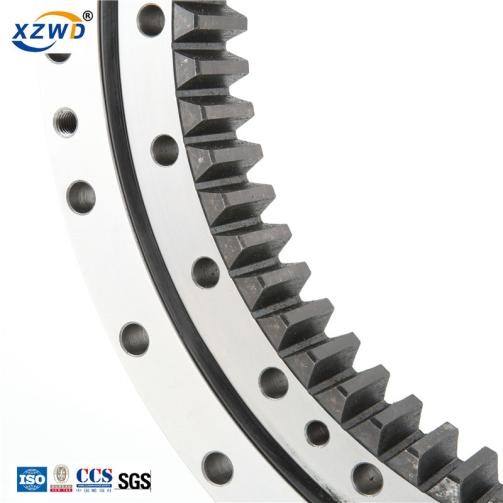When the excavator has abnormal noise when it is rotating, if there is a noise in a certain position during the full revolution, it must be tested. Consider whether the pinion gear and the large ring gear have broken teeth. At the same time, tooth fracture of large ring gear of the excavator is also the most common problem. Tooth fracture usually occurs in the upper half of the tooth width direction, and the fracture surface intersects the upper end surface of the tooth and forms an angle of 45°~60°. Even if the whole tooth falls off, the crack is caused by the expansion from top to bottom.
Xuzhou XZWD has been working hard to find a solution to the problem of broken teeth in slewing bearings for excavators. The specific plan is divided into the following processes:
1. Ensure that the side clearance of the large and small gears is not less than 0.06X modulus.
For a 20-ton excavator, the module of the slewing bearing is 10 modules, and the tooth side clearance of the large and small gears is not less than 0.6mm.
In the excavator spare parts market, because customers don't pay much attention to the tooth side clearance when the large and small gears are engaged, the tooth breakage rate remains high, so we announced the relationship between the broken tooth and the tooth side clearance and let them understand the control of the tooth side clearance. No, the broken tooth of the slewing bearing is inevitable.
After several years of publicity, the tooth-breaking rate of the slewing ring has dropped from the previous 6% to about 5%.
2. 37° oblique gear slewing support. The gear part on the non-installation surface of the slewing ring gear is changed from the full tooth width to a chamfer of 37°, and the slewing ring will be artificially cut off the part that often breaks, so that the extrusion force cannot be concentrated when the pinion gear is displaced In the upper part of the tooth width, so that the gear part of the slewing ring will not produce extrusion cracks in the early stage of use, which can effectively delay the problem of early broken teeth of the slewing ring gear.
Through this improvement, after two years of statistics, the tooth breaking rate with this slewing bearing has dropped from the previous 5% to about 4%.
3. Rotating support of gears with gradual hardness. Since the broken teeth of the slewing ring are caused by extrusion, how to prevent extrusion of large and small gears is the key point. When the gear is subjected to induction hardening, the heating section of the gear is divided into three sections: the normal hard zone, the transition zone and the soft zone. The hardness of the hard zone is HRC5056, and the hardness of the soft zone is the quenched and tempered hardness of the steel matrix.
In this way, when the large and small gears are meshed and squeezed, the soft area of the upper end surface will be squeezed and deformed.
Without squeezing off. After a year of data statistics, there is no broken tooth phenomenon with this slewing bearing, which solves the problem of broken tooth very well.
Post time: Jan-28-2022

